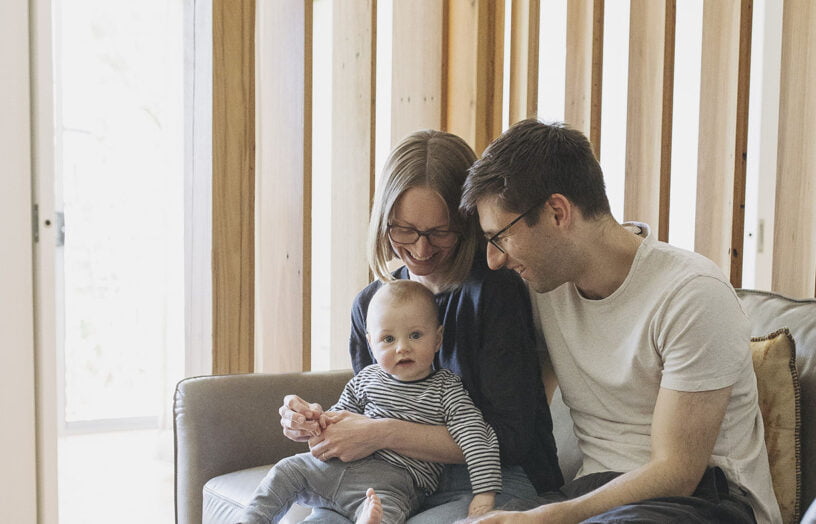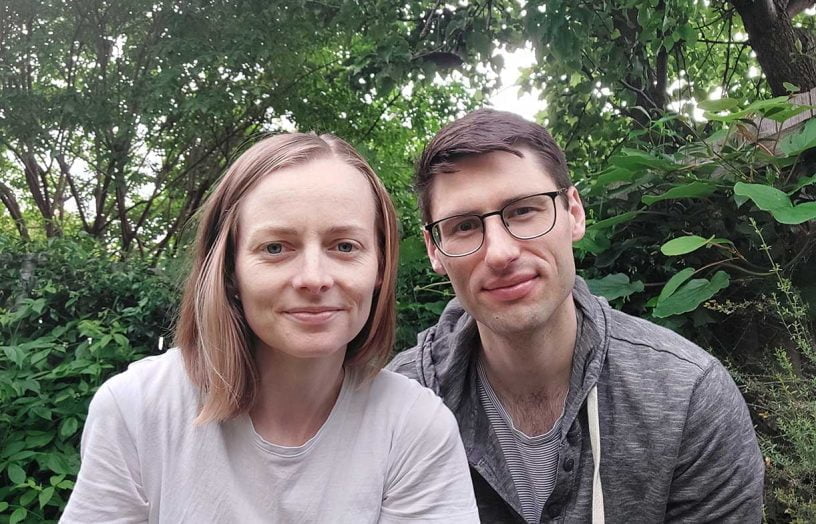Design workshop: A private sanctuary for retirement


After a busy farming life, Karin and Bruce Glen are looking forward to moving into town, downsizing, and having more time for gardening, entertaining friends and travel. Marie Carrel from Planet Architecture gives them some advice on achieving the low-maintenance, comfortable home they envisage.
For the past 35 years, Bruce and Karin Glen have been raising sheep and cattle and more recently growing culinary herbs on the family farm outside Euroa, a country town on the Hume Highway a couple of hours drive north of Melbourne. Now retiring, they have sold the farm and bought a block in town “to downsize our home, our workload and our lives”, says Karin. It’s a blank slate: 800 square metres and perfectly flat. “We chose this block for its location. It is quiet yet close to the town centre, hospital, schools and road access to Melbourne. But the block and surrounds are not very interesting, so all interest must come from the house design and garden.”
The couple would like a passive solar house with good privacy from the street, low maintenance requirements and minimal heating and cooling needs: “In short, a small, comfortable private sanctuary,” explains Karin. “We get quite cold winters here, including frosts, and very hot dry summers with temperatures around 40 degrees. I would like the morning sun in our master bedroom and the winter sun in our living area, but want it shaded in summer.” Shaded outdoor spaces are also a priority. The design will also need to address the challenges of a narrow northern street frontage and a 2.5 metre wide sewerage easement along the western boundary.
Karin has sketched a plan that features a living room and study to the front of the block, looking out to a north-facing courtyard garden enclosed with a high fence for privacy. The living room opens to a dining area and kitchen with a dining courtyard to the east. At the rear are two bedrooms looking east and south, plus a laundry, bathroom and ensuite.
Bruce and Karin would like some advice on the effectiveness of what they have envisaged. They also want to discuss rooflines, ceiling heights, building materials for the walls, and what they should consider in their design to enable them to stay in the house as they age and perhaps become less mobile. We asked Marie Carrel for her input. She’s director of Planet Architecture and an environmentally sustainable design specialist.

The brief
- Energy efficient, easy to maintain single storey two-bedroom home with study
- Passive solar design
- Large open comfortable living, dining, kitchen area with plenty of light, but not too hot in summer
- Enclosed courtyard garden facing north
Marie’s response
Karin and Bruce’s proposed floor plan is well thought out in terms of room size and flow between rooms. With the possible exception of a missing dedicated entry (useful for privacy and as an airlock) it is quite perfect, especially when you turn it around!
Orientation
If the proposed house design could be designed with the long sides of the house facing east and west (by turning the house 90 degrees), all the living areas and the two bedrooms could face north, and it would be a rather impeccable passive solar design.
However, the difficulty here is that the solar frontage is facing the street and sitting along the narrowest dimension of the block as well. The sewerage easement and the requirement for a garage accessed from the north further reduce the solar width available to the house. But in spite of these setbacks, we still want to use every bit of solar access available. We also want to make the most of the south-facing backyard which can often be left as utility space or dead space when a house is designed to face the other way.
Whatever your block orientation, it is a good idea to build close to the south boundary and to make the house as wide as possible in the east-west direction, so that as many rooms as possible can face north. This also helps to reduce the extent of east and west windows which are your enemies, because they admit unwanted sun in summer and very little of it in winter.
Three available options
There are three main strategies for dealing with blocks facing north to the street. The first is to build over two storeys, as it instantly doubles the available solar access, but Bruce and Karin want a single storey house. The second option is to locate the living areas to face the front and the sleeping areas to face the rear. This is fine, but it can be tricky to provide a large quiet open space at the front as well as provide substantial visual connection to the backyard. The third option – which we will look at in more detail – is to build the sleeping wing at the front (double glazed windows will ensure a peaceful night!) and a pod at the rear with the living zone.
Budget
Before we discuss the new approach, we need to look at Bruce and Karin’s budget. Although construction prices are presumably not as high in Euroa as they are in the big smoke, we will struggle to provide the 240 square metres they propose for a construction budget of $450,000. I would suggest that a size reduction of 20 per cent for a two-bedroom home with study and double garage requires a good rework of the floor plan, but is entirely feasible. It will ensure that every square metre of the home works hard without compromising on the desirable sense of space.
A ‘pod’ approach to light-filled living
Our proposal reflects Bruce and Karin’s original design but with the master bedroom and study at the front of the house with north-facing windows. The dedicated porch and entry provide a sense of arrival, privacy from living zones, and a handy space for leaving shoes and coats. The second bedroom and bathroom complete this ‘sleeping pod’. The living pod is connected to this front section with a covered link and is sandwiched between open garden spaces to both north and south. The north-facing courtyards are designed as entertainment spaces and are directly accessible from the living areas. The connecting link will shade one of the courtyards at either end of the day, providing a variety of options for dining outside. The L-shaped living areas have an overall north and east orientation to prevent overheating, which can be a problem in summer when the weather turns hot and dry in Euroa. The design also provides ready access to the rear where the owners will likely have a substantial productive garden.
Zoning and accessibility
Separating the house into two distinct pods provides complete privacy to the living area as well as doubling up the solar frontage. The kitchen ceiling rakes up towards high clerestory windows which bring light deep into the house. The house has a level floor throughout, and small ramps plus the provision of wider-than-standard 870mm doorways can accommodate wheelchair entry should this be required later on.
Ceilings and roofline
Suitable ceiling heights would be 2.7m in the front pod, 2.4m in the link and over the dining area, and 2.55m raking to 3.5m over the kitchen and lounge space. While the roof shape at the front could be flat or a gable, the link and dining area should be flat-roofed to accommodate the clerestory windows on the southern end. The rest of the rear pod would work well with a skillion roof.

Cladding
Cladding could include a variety of cement sheets, corrugated iron, or solid or composite timber with possible accents of stone or blockwork. As Bruce and Karin are probably not keen to maintain solid timber decking, I would suggest they use composite timber, selecting one with a good percentage of recycled plastic.
Windows
It would be preferable for all windows to be timber-framed and double-glazed with a 14mm or 16mm air gap. Filling the gap with argon gas increases insulation by about 10 per cent again and is worth having. While good windows are never going to be cheap, the Window Energy Rating Scheme website can help you make a pre-selection of the best ones so you can obtain and compare several quotes.
Floor slab and heating
A concrete slab floor would make sense on such a flat block, provided a ‘green’ concrete mix is specified. Slab-edge insulation is necessary, as well as under-slab insulation. Bruce and Karin are not keen to heat the bedrooms, which means that a simple, energy-efficient heater in the living area would suffice; a door should be installed between the link and the dining space to act as an air lock.
Should they wish to heat the front pod as well, hydronic in-screed heating would be a great solution. The water is heated to a relatively low temperature with a gas-fuelled boiler or a heat pump – the latter system is costlier but can help the house move toward being gas-free while providing the comfort of hydronic heating.
Summer cooling
Summer comfort can be improved with ceiling fans, proper shading of north-facing openings and increased thermal mass – think reverse brick veneer for some of the walls. While most homes will still need cooling, it is worth spending a summer without it to see how the house performs when properly operated – windows closed and shades down during the day and windows open at night. You may find that this is enough, along with a good planting of deciduous trees, to provide a 10 to 15 degree temperature differential during the hottest part of the day. Ensure deciduous trees are chosen with slim limbs and trunks or they could still provide unwanted shade in winter.
Energy generation
Solar panels could either sit at the front where the roof shape is on a 30 to 35 degree incline or propped on the rear pod roof – they will only be visible from the backyard then. Solar panel technology changes quickly and it is best to talk to well-established suppliers to get a proposal in view of your needs and budget.
More Design Workshop articles
 Design workshop
Design workshop
Design workshop revisited: Small space success
With some small but important changes to the internal layout based on our expert’s advice, this expanding young Canberra family is getting more out of their diminutive apartment.
Read more Design workshop
Design workshop
Design workshop: Making a small space work harder
Young professional couple Jess and David love their diminutive Canberra apartment and the productive courtyard garden they have established, and would like to make changes to maximise natural light, make the most of the available space, and accommodate a future family. Small space expert Kate Shepherd of Rob Henry Architects is on hand to help.
Read more Design workshop
Design workshop
Design workshop: A higher-performing volume build
Kirsten and James are keen to make the project home they’re planning in Camberwell, Victoria, as energy-efficient and comfortable as possible, and have budgeted for some upgrades. Architect Penny Guild and ESD consultant Erika Bartak give the couple some advice on achievable tweaks to improve their home’s performance.
Read more

